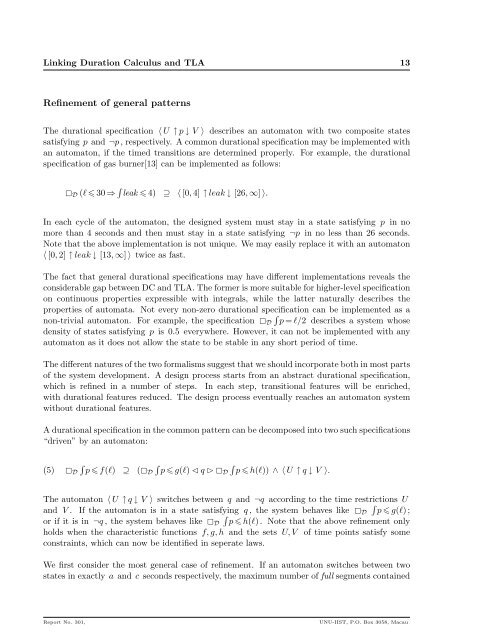IIST and UNU - UNU-IIST - United Nations University
IIST and UNU - UNU-IIST - United Nations University
IIST and UNU - UNU-IIST - United Nations University
You also want an ePaper? Increase the reach of your titles
YUMPU automatically turns print PDFs into web optimized ePapers that Google loves.
Linking Duration Calculus <strong>and</strong> TLA 13<br />
Refinement of general patterns<br />
The durational specification 〈 U ↑ p ↓ V 〉 describes an automaton with two composite states<br />
satisfying p <strong>and</strong> ¬p , respectively. A common durational specification may be implemented with<br />
an automaton, if the timed transitions are determined properly. For example, the durational<br />
specification of gas burner[13] can be implemented as follows:<br />
D (l 30 ⇒ ∫ leak 4) ⊇ 〈 [0, 4] ↑ leak ↓ [26, ∞] 〉.<br />
In each cycle of the automaton, the designed system must stay in a state satisfying p in no<br />
more than 4 seconds <strong>and</strong> then must stay in a state satisfying ¬p in no less than 26 seconds.<br />
Note that the above implementation is not unique. We may easily replace it with an automaton<br />
〈 [0, 2] ↑ leak ↓ [13, ∞] 〉 twice as fast.<br />
The fact that general durational specifications may have different implementations reveals the<br />
considerable gap between DC <strong>and</strong> TLA. The former is more suitable for higher-level specification<br />
on continuous properties expressible with integrals, while the latter naturally describes the<br />
properties of automata. Not every non-zero durational specification can be implemented as a<br />
non-trivial automaton. For example, the specification D<br />
∫<br />
p = l/2 describes a system whose<br />
density of states satisfying p is 0.5 everywhere. However, it can not be implemented with any<br />
automaton as it does not allow the state to be stable in any short period of time.<br />
The different natures of the two formalisms suggest that we should incorporate both in most parts<br />
of the system development. A design process starts from an abstract durational specification,<br />
which is refined in a number of steps. In each step, transitional features will be enriched,<br />
with durational features reduced. The design process eventually reaches an automaton system<br />
without durational features.<br />
A durational specification in the common pattern can be decomposed into two such specifications<br />
“driven” by an automaton:<br />
(5)<br />
D<br />
∫<br />
p f(l) ⊇ (D<br />
∫<br />
p g(l) ⊳ q ⊲ D<br />
∫<br />
p h(l)) ∧ 〈 U ↑ q ↓ V 〉.<br />
The automaton 〈 U ↑ q ↓ V 〉 switches between q <strong>and</strong> ¬q according to the time restrictions<br />
∫<br />
U<br />
<strong>and</strong> V . If the automaton is in a state satisfying<br />
∫<br />
q , the system behaves like D p g(l) ;<br />
or if it is in ¬q , the system behaves like D p h(l) . Note that the above refinement only<br />
holds when the characteristic functions f, g, h <strong>and</strong> the sets U, V of time points satisfy some<br />
constraints, which can now be identified in seperate laws.<br />
We first consider the most general case of refinement. If an automaton switches between two<br />
states in exactly a <strong>and</strong> c seconds respectively, the maximum number of full segments contained<br />
Report No. 301,<br />
<strong>UNU</strong>-<strong>IIST</strong>, P.O. Box 3058, Macau
















